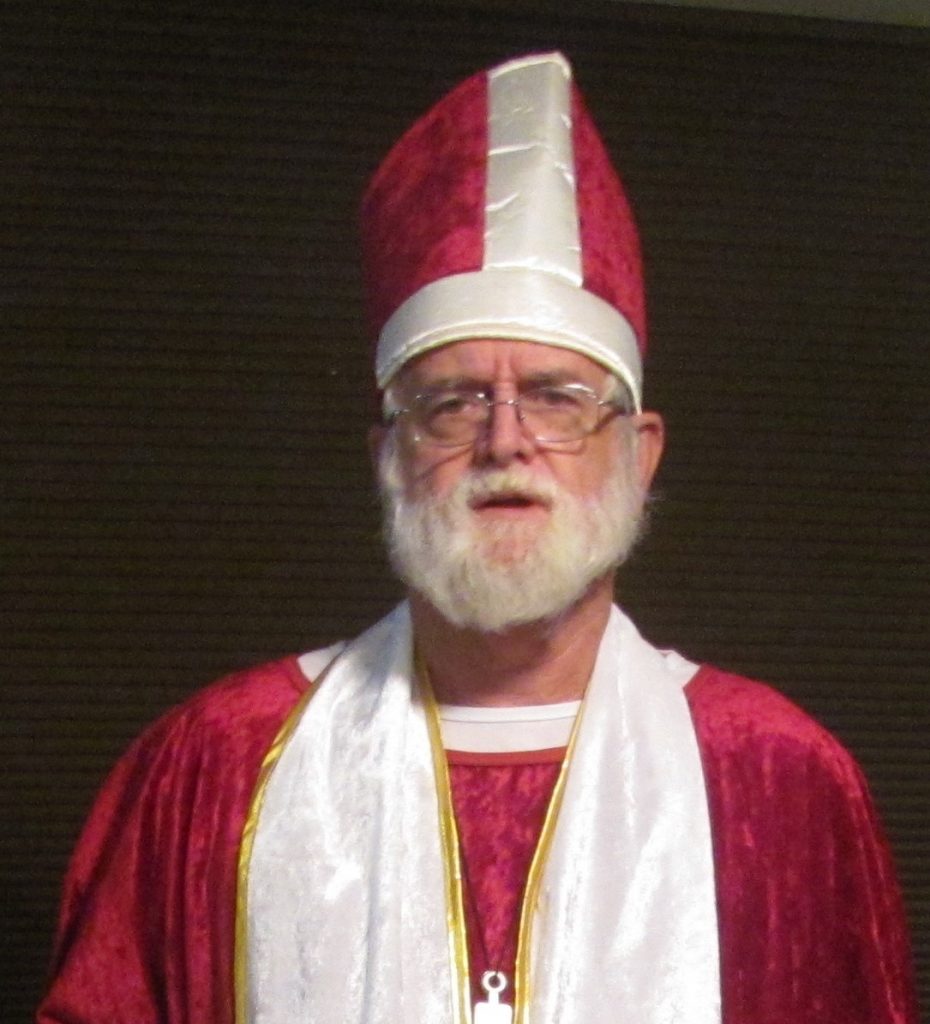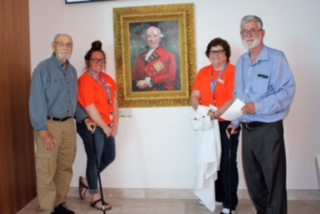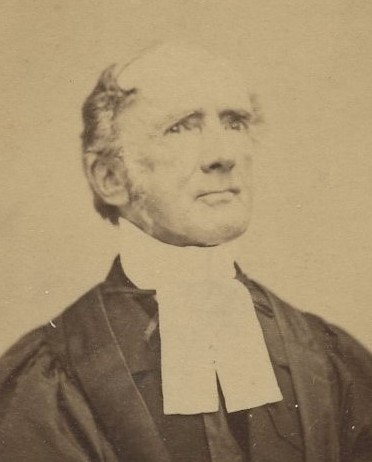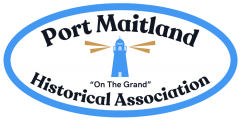Bill’s Post
August 2022

–
But First!
On June 18th the new County Administration Building held its official opening. Most of the councillors attended as did the Mayor and much of the senior staff. I am not sure what attendance was anticipated. It was a nice sunny warm; but not too warm day. One can understand the citizens of Haldimand choosing to have a BBQ rather than attend an opening of a building that has in effect been open for about two years.
What drew me to the event was that the Port Maitland, “On the Grand” Historical Association had made a presentation to Council in October 2018 that a portrait of Sir Frederick Haldimand be commissioned and painted by William Biddle of Dunnville. The portrait was to be hung in a prominent location in the new administration building. Today would be its official unveiling and I needed or should I say wanted to be there.

William Biddle, Megan Turner, Anne Unyi, Bill Warnick
All in all, it was a good day where I met some old friends and a few new ones. Upon returning home I stopped at the Adam Young Commemorative Plaque on Hwy 54 and ran into Bobbie Ann Brady Haldimand/Norfolk’s new independent MPP. After a brief chat with her I continued along Hwy 54 to York where, when there I discovered some people at the former St. Paul’s Anglican Church. Some of you may remember seeing a Hamilton Spectator story a few months ago of a young couple from Toronto who purchased the church and had to take the cemetery in the bargain. When I saw the story I was quite concerned that the cemetery might not get the attention its inhabitants deserved. After a very slow drive past it while taking a good look, I was intrigued and pleased with what I was seeing. If you know me, you know I am not shy, so why not turn around and make a visit to the lady and her grandchildren who were sitting in the churchyard?
After a proper introduction, Anne Deacon kindly sent one of her grandchildren into the church to have his parents come out. Tao Drayton and Andresa Sisson soon arrived with a cameraman in tow. In the Drayton/Sisson family Anne is referred to as Andresa’s Mother-in-love. A friend of Tao and Andresa, Sean Liliani, is filming a pilot show for TVO. It consists of many compiled interviews with hopefully about 5 minutes featuring the church and cemetery.
After our introduction, I told them of my day at Cayuga and a tidbit about Sir Frederick Haldimand. A look to my right and I discovered I was being taped which was fine. Soon a permission form to use the footage was in front of me which I signed. Then Sean asked me to move to a better site on the property where he could ask me some questions and have better lighting. Once there he asked me to tell him about Rev. Bold Cudmore Hill. I said WHO! “Rev Bold Cudmore Hill” he repeated, “he is buried out there in the cemetery!” Well that; or should I say HE is news to me! Sean and Tao proceeded to tell me that Rev Hill was an Anglican Saddleback preacher who opened parishes amd was an early Priest at a number of churches in Haldimand County including Christ Church Port Maitland, St. John’s South Cayuga, St. Paul’s Dunnville, St. Paul’s Caledonia – earlier known as Seneca, St. Paul’s York and others. I suspect Rev. Hill took the name St. Paul at his confirmation, but I don’t know that! He rode his horse from village to village bringing the sacraments of Baptism and Eucharist while providing spiritual services and guidance to the people of Haldimand. This would include guiding them in the establishments of many new parishes and the building of their early churches, some of which stand today. He rode that horse(s) around Haldimand from 1838 until 1870.

Rev. Bold Cudmore HillBefore I continue, I must urge you to visit the Haldimand Press news article about the new owners of the former St. Paul’s church and cemetery in York.
I am a great, great, great stepchild of a Roman Catholic circuit priest the Rev. Edward Gordon well-known in my Dioceses historic records. (Well this is yet another story.) Any story of a circuit preacher who preached in Haldimand and who had a name like Bold Cudmore Hill and died falling of a horse at 71 years of age catches my attention.
Sometimes a story is as much about the process as it is the story. Something tells me that this may turn out that way. I really want to return to York and stand in front of that camera and tell about the long and interesting life of Rev. Hill. Good fortune and some conflict has led me to meet the Venerable Bill Mous the Executive Officer & Secretary of Synod for the Anglican Diocese of Niagara. My first email was to him. He forwarded me a link which is an article written in 2013 by the recently late Barbara Martindale and former owner of the Sachem, a Caledonia area newspaper.
Barbara’s article gives a one and one half page of scattered facts about Rev. Hill. I will repeat a number of them here and even sometimes take verbatim what she writes. Rev. Hill immigrated to Canada after earning his Masters in Theology from Trinity College, the University of Dublin and established parishes in Dunnville, Canboro, Cayuga, Jarvis, Nanticoke, Caledonia, and of course York, geographically central in his territory, where he build a parish house. His area of responsibility also extended into Glanford in Wentworth County. Only nine days after learning from his Bishop that he would be a saddleback preacher along the swampy Grand River he held his first service on Friday October 21, 1831 in a tavern in Cayuga.
Rev. Hill was not the first Anglican minister to serve the people of the Hamilton/Haldimand and Niagara area. From Mary Mellish’s writing – “Haldimand And the Church of England The Early Years” she writes “The first Church of England clergyman to visit the Grand River region (and the first to be resident in Ontario) was Rev. John Stuart.” There were others but this article is not about them.
Most minister/priest etc. are intelligent people but Rev. Hill is believed to have been a cut above most and such was appointed as a school commissioner for the area where he prepared students for university and professional life.
To take directly from Barbara’s article – a eulogy by Richard Harcourt:
“The Honorable Richard Harcourt of York and a student of Rev. Hill wrote a tribute. Mr. Harcourt said, The people of Haldimand might well erect a monument in loving memory of this saintly pioneer clergyman - a lonely figure on horseback - to be placed on one of the highways he travelled by day and by night, winter and summer, addressing scattered audiences in small school houses or ministering to the spiritual needs of the sick and dying." And - Richard Harcourt also described him as A man of medium height, lithe figure and somewhat stooped, penetrating light blue eyes, always gentle yet firm. His sermons were mainly taken from St. Paul's epistles.
Barbara’s article also tells us that his early services in Caledonia took place in Bryant’s Inn in Caledonia. I have had some trouble exactly identifying where the Byant’s Inn was located but it was very close to the Grand River on its east side on Argyle St. which to many of us is the former Highway # 6.
Barbara writes that extensive information regarding Rev. Hill was obtained by Mary Mellish referred to above, who wrote a comprehensive summary of his life.
From a book “No Longer Strangers” by Rev’d William R. Blott is found the following reference to Rev’d Hill.
Four Weddings – The hopes of those first arrivals in the Lakeshore Settlement, and their sometime downheartedness at the challenges that faced them, were ministered to by the Rev’d Bold Cudmore Hill, the “missionary of the Grand River”. He would come riding on horseback with his Prayer Book and Bible, vestments and traveling Communion set packed in his saddlebags, and with tales to tell of his journeys along lonely roads and down various waterways. (One such winter’s tale passed down in the author’s family is of his being chased through the bush by wolves.) It was Hill who married William A. Johnson and Laura Jukes on the 13th of December 1836. (See Grand Dispatch pg. 9 fall 2016, for an article on the Jukes family “Thank you for your kindness Dr. Jukes” Louis Riel”). The service would have been conducted in the bride’s home since there was no church building, and this was the case when on February 27, 1839 William Blott and Alice MacGregor were married “at home on the Lakeshore”. However, change was about to come.
Rev. Bold Cudmore Hill was born in Limerick, in Southern Ireland on October 16, 1799. The name Bold was his mother’s maiden name. It was an old Irish custom to name the second son after the mother’s maiden name. On Nov. 8, 1841, at age 42 he married 31 year old Isabella Jeffrey in Canandaigua NY. She was born on March 1, 1810 in Edinburgh, Scotland. They had four children.
- Jeffrey would attend the University of Toronto receiving his M.A. He then attended Huron College in London Ont. Jeffrey served in a number of parishes in South Western Ontario and the Bruce Peninsula. Jeffry was a veteran of the Fenian Raids.
- Arundel Charles would rise to the status of Archdeacon of the Diocese of Toronto. Articles on him state he was born in York but his Marriage record states he was born in Hamilton Ont. However, I suspect York is correct.
- Renwick, whom I know little about other than he died in Meaford, Grey County at the age of 30. I find no record of his ever being married.
- Elizabeth Catherine who died at York at age 21.
What is missing from this story?
- Was Rev. Hill an easy person to get along with as suggested in his eulogy above? After all, eulogies tend to bring out only the best in people.
- We know he often preached from the Gospel of St. Paul – why? Did he feel he has some similarity in life to St. Paul? I.e. could he have felt he started life on the wrong foot as did St. Paul and now as St. Paul he must teach and serve the Gospels?
- Who were his closest friends?
- Did he leave written diaries or journals that would tell us more about him? If so, where are they?
I personally would like to know:
- How many horses he wore out and what were there names and why were they named as they were?
- What was the name of the horse he fell from?
- How many miles did he travel on horseback to serve his Anglican charges?
It is important to clear up one thing and make note of another. The photo at the top of the post is of me as I had dressed for Halloween 2015 at my grandchildren’s school. It is not Rev. Hill!!!
This article could not have happened had I not stopped at the former St. Paul’s church in York where I met Tao and Andresa. It is also the result of assistance I received from Canon Bill Mous at the Anglican Diocese of Niagara, Rev. Cheryl Barker Pastor at St. Paul’s Anglican church in Caledonia, Anne Ynyi of the County of Haldimand, Mary Mellish who’s research provided most of the information herein, Kathy Blott who gave me the information from her father’s book and of course my old friend the late Barbara Martindale.
As stated above, I thought this article may be more about process than fact. It seems to have turned out that way. I did learn more, much more but my “Post’s” are not intended to be a trilogy. I believe this article should end now with a comma and three dots. , . . .
